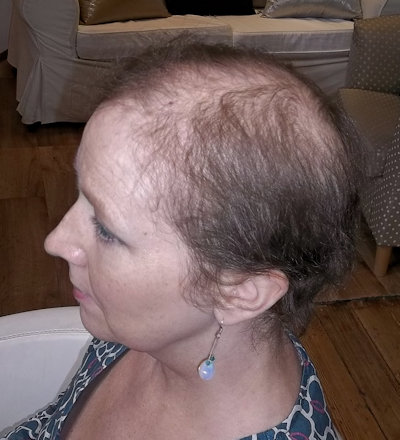Thinning Hair in Women
How to recognize and manage it
What exactly is Thinning Hair?
To take the most appropriate action you need to understand the different causes and types of hair loss. A number of conditions can result in thinning hair and some of them work differently in women than in men.
In men it's common for hair to recede from the front or from just above the temples, and this often results in baldness to a greater or lesser extent; indeed it is usually referred to as “male pattern baldness”.
In women this type of receding hairline is much less common, unless they happen to suffer from a much rarer condition called Frontal Fibrosing Alopecia. Instead it's much more likely that they will find that their hair gets gradually thinner over most of their head, and as you get older this becomes more likely due to hormonal changes starting around the menopause. You may hear this referred to as Female Pattern Hair Loss (FPHL), but the term can be confusing as there isn't really a pattern - it's a diffuse overall thinning rather than the much more distinct pattern that is seen in men.
Note that this is quite different to the often random patches of complete hair loss seen in Alopecia Areata.
However there are other causes that can produce thinning - these can be temporary factors such as trauma, stress, ilness or childbirth, that halt new growth for a while - a condition called Telogen Effluvium where the hair follicles stay in either or both a shedding phase or a resting phase longer than usual - or they can be medical issues that, once recognised and treated, allow the hair to gradually recover. This is why we always encourage women to see a doctor first to ensure that they get such medical conditions either diagnosed and treated, or eliminated as a possible cause.

Hilary's hair showed considerable thinning

Hilary after having an Intralace System application
Causes and Types of Thinning Hair
Causes
- Hereditary
- Hormonal changes due to the menopause
These two are the most likely causes of FPHL.
- Hormonal changes due to pregnancy and childbirth
- Stress
- Weight loss
- Trauma - whether psychological or physical
These are the most common causes of Telogen Effluvium.
Treatments are available for FPHL - but don't always work, or need far more testing
Medications
There are a number of medications that may be prescribed by a Dermatologist. These should be considered very carefully as some of them such as Minoxidil should be avoided in anyone who plans to have a pregnancy or who is breastfeeding. All of the available medications can cause side-effects and all of them, if they are effective at all, are only effective for as long as you continue taking them.
Transplants
More traditionally used for men, these are becoming more common in women. However they are not always applicable for women especially if thinning has progressed to the point that the hair is very sparse.
Lasers
Various combs and helmets that produce low levels of laser light are claimed to help stimulate hair follicles into growth. Evidence for this is rather sketchy and even if they do work you need to use them long-term.
Plasma Therapy and Stem Cell Therapy
These two fairly recent developments from the US are still experimental. They should only be considered in consultation with a Dermatologist.
Supplements and Vitamins
You'll find no end of products that claim to help regrow your hair - it's the natural environment of snake oil salesmen. Most supplements that have been tested have shown no effect at all. Some of them may also interact with other medications. Again you should talk to your Dermatologist about any supplements you might be thinking of taking, while they are in the best position to check whether any positive tests have been undertaken on them.
Treatments for Telogen Effluvium are based around removing the cause
Thinning caused by Telogen Effluvium will often resolve itself once the underlying cause is removed. Recovering from an accident or from surgery for instance will be a gradual process and your hair will recover naturally. Whether medical assistance is necessary will naturally depend on the exact circumstances and if stress-related will require that the causes of that stress are lessened.

Tracy had considerable thinning

Tracy wearing her Intralace System
Managing and Disguising Thinning Hair where there is no treatment available
This is where Lucinda Ellery's techniques for disguising hair loss really come into play. although they may also help earlier in the process while causes and diagnoses are still being evaluated.
Typically early stage thinning can be hidden effectively by our ultra-fine hair extensions - called Medi Connections.
Later stage thinning, especially where there is loss in the front hair line, parting or crown, is often best handled by using our Intralace Minima.
Advanced thinning may require the full Intralace System™. Both these two types of Intralace use an extremely fine mesh through which your existing hair is gently teased and to which further hair is added. Fuller details can be seen on the Intralace page while examples of the effect it can have on cases can be seem on the Intralace Gallery.
Come and talk to us
Whatever questions you may have - and we know that everyone has questions and worries when faced with hair loss - we'll be happy to talk to you and answer them as well as we can. You can be certain that you'll be listened to in privacy and with empathy.
Our locations
Los Angeles
9022 Burton Way
Beverly Hills,
CA 90211
New York
Suite 607, 37 East 28th Street
New York, NY 10016
London, England, UK.
Also in Manchester, England, UK. Edinburgh, Scotland, UK. Bristol, England, UK, The Midlands, England, UK, Southampton, England, UK.
Take the Next Step
To arrange a free private consultation at The Lucinda Ellery Consultancy please call:
(310) 288-0788 - Los Angeles USA
or use the LA contact form
(212) 359-1641 - New York USA
or use the New York contact form
For UK and other international inquiries please call
+44 208 741 8224 - (London) England, UK
or use the London contact form
or you may wish to visit our UK website
